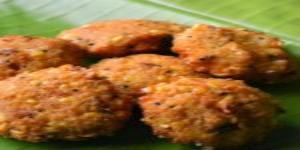
Scope
Vadai is a category of savoury fried snacks. It is known by different names in different languages – wada, vade, vadai, wadeh and bara, refer to the same snack type.Different types of vadas are made from different ingredients, ranging from lentils to potatoes, chickpeas, rice flour, etc. They are often served as a breakfast item or a snack, and also used in other food preparations (such as dahi vada and vada pav). The most popular vadai is the ulundu vadai also called medu vada, which is made from dehusked blackgram dal. Rich in protein, the ulundu vadai is a favorite offering to the deity Kalabhairava, especially in the state of Tamil Nadu.
This snack finds mention in early Indian texts belonging to the Sangam period of Tamil Nadu and also in the Manasaollasa, a 12th century Sanskrit encyclopedia compiled by Someshwara II, who ruled over large parts of present day Karnataka. Many Indians, who were sent as indentured laborers to various Carribean islands, Mauritius, Fiji, etc. by the British, who now form an important part of the Indian diaspora there have made bara an important part of their
cuisine. Bara is made of split mung beans/green gram (moong dal).
Fundamental Concepts and Principles
Vadai (Vada) may be made from split dehusked or husked lentils/legumes, sago or potatoes. Commonly used legumes include pigeon pea, chickpea, black gram and green gram. Vegetables and other ingredients are added to improve taste and nutritive value.
Fundamental Concepts and Principles
Following ingredients are required for making Moong Dhal Aama Vadai :
- Chana dal/Bengal gram – ¼ padi
- Urad dal/black gram – veesam 3/16 padi
- Toor dal/pigeon pea – 1/8 padi
- Moong dal/yellow gram – 1/16 padi
- Salt – ¾ palam
- Green chillies – 2 palam
- Red chillies – 1/8 palam
- Turmeric powder – 1/8palam
- Asafetida – veesam 1/16-rupee coin size
- Sesame oil/til oil – 25 palam
Method
For legume-based vadas, the legumes (dal) are soaked with water, and then ground to a batter. Other ingredients, such as cumin seeds, onion, curry leaves (sometimes previously sauteed), salt, chillies or black peppercorns are added. Often ginger and baking soda are added to the seasoning in shops to increase the fluffy texture and improve fermentation. The mixture is then shaped and deep-fried, resulting in vadas with a crispy skin and fluffy centre.
Vadais are preferably eaten freshly fried, while still hot and crunchy. They are served with a variety of dips including sambar, wet or dry chutneys and dahi/mor (yogurt/curds) Medu/ulundu vadai are typically served along with a main course such as dosa, idli, or pongal with coconut chutney and sambar as accompaniments.
Method
- Soak Bengal gram, Black gram, Pigeon Pea, Yellow or Green gram. Soak all these dals in water and after it is soaked well, remove the water and put it in the grinder.
- Add salt, green chillies, red chillies, turmeric, asafetida. Put all this in the grinder and grind well. Heat sesame oil in an iron pan and when it stops spluttering, flatten the lemon sized balls in an oiled banana leaf and drop it slowly in the oil. Drop 7 or 8 vadas into the oil and turn the vadas when one side is slightly red. Repeat this procedure for all the vadais.
Hindu Compliance Body
The Hindu compliance body was established under the executive order of The Supreme Pontiff of Hinduism, dated August 14, 2020, order number 10010, under the title Reviving the Hindu Compliance System and Body
to create, promote, spread and teach the standard procedures for all products and services that are in compliance Hindu Shastras.
Copyright
HCS has the copyright of all its publications. No part of these publications may be reproduced in any form without the prior permission in writing to HCS. This does not preclude the free use, in the course of implementing standard, of necessary details mentioned above. Enquiries related to copyrights to be addressed to KAILASA.
